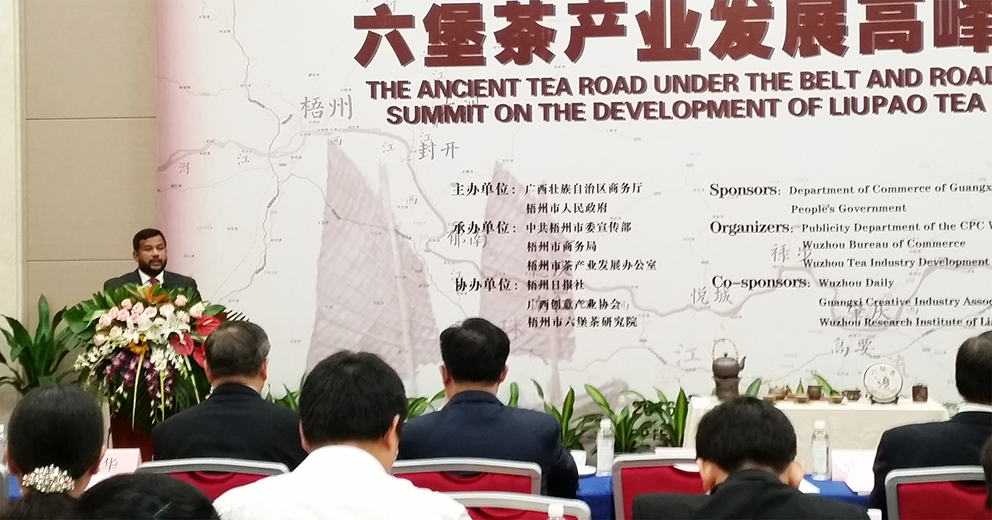No less than a quarter of tea imports to the world’s largest tea market are Ceylon Tea-and “Ceylon Tea” is also the first international branding hit for Sri Lanka in modern times, revealed a top Lankan Cabinet Minister on 11 September in Nanning, China.
“Ceylon Tea became the first Sri Lankan commodity to create international country branding success for Sri Lanka in modern times” said Minister of Industry and Commerce Rishad Bathiudeen on 11 September addressing Vice-Chairman of Guangxi Zhuang Autonomous Region Zhang Xiulong. Minister Bathiudeen was in discussions with Vice-Chairman Xiulong on the side-lines of CAEXPO 13 international expo in Nanning (capital of Guangxi Zhuang Autonomous Region), China. Minister Bathiudeen was leading the 23 member Sri Lankan trade and business delegation to Nanning’s CAEXPO13. After meeting Vice-Chairman Xiulong, Minister Bathiudeen also addressed the well-attended Summit on Development of Liu Pao Tea Industry held at Nanning International Conference Centre, Nanning.
China is the world’s largest tea market, valued at more than $ 9 billion. The second largest market, Russia is almost half that of China’s at $4 Billion. China was also the country that originally gave Sri Lanka its first tea plants.
“We thank the people of China for giving the first ever tea plants to us” said Minister Bathiudeen and added: “Ceylon Tea is one of the three main exports to China from Sri Lanka. Our tea export volumes to China in the ten year period of 2005-2015 has increased greatly. By last year more than one fourth -that is 26 percent of China’s tea imports- were supplied by Sri Lanka.”
Vice-Chairman Xiulong stressed of the strong and historic Chinese-Sri Lanka relations and added: “We are pleased to receive Ceylon Tea. I also stress about the variety, value and production quantity of Guangxi’s tea, the history of Loubao tea of Wuzhou city. I am also pleased to inform you that we have a new plan for Guangxi’s tea development. I invite you and Sri Lankan merchants to visit Guangxi and Wuzhou tea industry for a greater understanding with an eye to future tea industry cooperation between both countries.” Minister Bathiudeen positively responded to Vice-Chairman Xiulong’s invitation and stressed he would instruct his officials accordingly. Thereafter Vice-Chairman Xiulong invited Minister Bathiudeen to address the Summit on Development of Liu Pao Tea Industry at held at the same time and venue in Nanning which was accepted by Minister Bathiudeen.
Addressing the Liu Pao tea summit, Minister Bathiudeen said: “Tea was introduced to Sri Lanka from China in 1824. The British brought the first tea plants from China to Sri Lanka in 1824 starting our historic tea journey. Our brand of exported tea gradually became known as Ceylon Tea across the world. As a result Ceylon Tea became the first Sri Lankan commodity to create international branding success for us in modern times. Ceylon Tea is one of the three main exports to China from Sri Lanka, in 2015, it was the third largest export to China. In fact we have been fortunate enough to establish ourselves so well in China. Our tea export volumes to China in the ten year period of 2005-2015 has increased by a huge 1400 percent. Also by last year more than one fourth -that is 26 percent of China’s tea imports- were supplied by Sri Lanka. This is around 4760 metric tons from the total 18000 tons of tea imported by China from many parts of the world in 2015” said Minister Bathiudeen and added: “Among the main reasons for increasing demand for Ceylon Tea in China could be our quality assurance changing consumer trends here and efforts of our government institutions such as the Tea Board. Today Ceylon Tea is a $ 1.5 billion industry. Among the reasons for Ceylon Tea to become a $1.5 billion industry is Sri Lanka being the second largest exporter and third largest producer of orthodox tea in the world. Around 222000 hectares of tea is planted in Sri Lanka. We produce 15 grades of tea from these 222000 hectares. Almost half of the 222000 hectares is grown 600 metres below sea level. These are called as low grown tea. Sri Lanka is also the only tea-producing country where all tea grown is 100% ozone friendly. Sri Lanka has established its reputation well for premium tea with strict quality control regulations. To rebrand Ceylon Tea we also launched new logos for Ceylon tea under the “Geographical Indicators” international trade system. The objective is to raise Ceylon Tea to premium product levels such as French wines and Pakistani Basmathi rice. Ceylon Tea produced in Sri Lanka is eligible to use Geographical Indicator Logo. Only those teas meeting the high standards being awarded the use of famous “Lion Logo” which is a sign of good quality.”
In 2015, the top three Lankan exports to China were Boats, Apparel and Bulk Tea. The $27 Mn bulk tea exports in ’15 were a strong 31% surge from 2014’s $18 Mn bulk tea exports to China from Sri Lanka.

